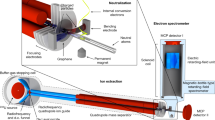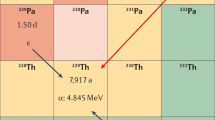Abstract
229Th is the only nucleus currently under investigation for the development of a nuclear optical clock (NOC) of ultra-high accuracy. The insufficient knowledge of the first nuclear excitation energy of 229Th has so far hindered direct nuclear laser spectroscopy of thorium ions and thus the development of a NOC. Here, a nuclear laser excitation scheme is detailed, which makes use of thorium atoms instead of ions. This concept, besides potentially leading to the first nuclear laser spectroscopy, would determine the isomeric energy to 40 μeV resolution, corresponding to 10 GHz, which is a 104 times improvement compared to the current best energy constraint. This would determine the nuclear isomeric energy to a sufficient accuracy to allow for nuclear laser spectroscopy of individual thorium ions in a Paul trap and thus the development of a single-ion nuclear optical clock.
Similar content being viewed by others
References
Ludlow, A.D., et al.: Optical atomic clocks. Rev. Mod. Phys. 87, 637 (2015)
Huntemann, N., et al.: Single ion atomic clock with 3 ⋅10− 18 systematic uncertainty. Phys. Rev. Lett. 116, 063001 (2016)
Chen, J.S., et al.: Sympathetic ground state cooling and time dilation shifts in an 27al+ optical clock. Phys. Rev. Lett. 118, 053002 (2017)
Nicholson, T.L., et al.: Systematic evaluation of an atomic clock at 2 ⋅10− 18 total uncertainty. Nat. Commun. 6, 6896 (2015)
McGrew, W.F., et al.: Atomic clock performance enabling geodesy below the centimetre level. Nature 564, 87–90 (2018)
Peik, E., Tamm, C.: Nuclear laser spectroscopy of the 3.5 eV transition in 229Th. Eur. Phys. Lett. 61, 181 (2003)
Campbell, C.J., et al.: Single ion nuclear clock for metrology at the 19th decimal place. Phys. Rev. Lett. 108, 120802 (2012)
Borisyuk, P.V., et al.: Trapping, retention and laser cooling of th3+ ions in a multisection linear quadrupole trap. Quantum Electron. 47, 406–411 (2017)
Thielking, J., et al.: Laser spectroscopic characterization of the nuclear-clock isomer 229mTh. Nature 556, 321–325 (2018)
Rellergert, W.G., et al.: Constraining the evolution of the fundamental constants with a solid-state optical frequency reference based on the 229Th nucleus. Phys. Rev. Lett. 104, 200802 (2010)
Kazakov, G.A., et al.: Performance of a 229Thorium solid-state nuclear clock. New J. Phys. 14, 083019 (2012)
Jeet, J., et al.: Direct search using synchrotron radiation for the low-energy 229Th nuclear isomeric transition. Phys. Rev. Lett. 114, 253001 (2015)
Borisyuk, P.V., et al.: Experimental studies of thorium ion implantation from pulse laser plasma into thin silicon oxide layers. Laser Phys. Lett. 15, 056101 (2018)
Stellmer, S., et al.: Attempt to optically excite the nuclear isomer in 229Th. Phys. Rev. A 97, 062506 (2018)
Beck, B.R., et al.: Energy splitting of the ground-state doublet in the nucleus 229Th. Phys. Rev. Lett. 98, 142501 (2007)
Beck, B.R., et al.: Improved value for the energy splitting of the ground-state doublet in the nucleus 229mTh LLNL-PROC-415170 (2009)
Minkov, N., Pálffy, A.: Reduced transition probabilities for the gamma decay of the 7.8 eV isomer in 229Th. Phys. Rev. Lett. 118, 212501 (2017)
Tkalya, E.V., et al.: Radiative lifetime and energy of the low-energy isomeric level in 229Th. Phys. Rev. C 92, 054324 (2015)
Tkalya, E.V., et al.: Processes of the nuclear isomer 229mTh(3/2+, 3.5 ± 1.0 eV) resonant excitation by optical photons. Phys. Scr. 53, 298–299 (1996)
von der Wense, L., et al.: Towards a 229Th-based nuclear clock. Meas. Tech. 60, 1178 (2018)
Kazakov, G.A., et al.: Prospects for measuring the 229Th isomer energy using a metallic magnetic microcalorimeter. Nucl. Instrum. Meth. Phys. Res. A 735, 229 (2014)
von der Wense, L., et al.: Direct detection of the 229Th nuclear clock transition. Nature 533, 47 (2016)
Seiferle, B., et al.: Lifetime measurement of the 229Th nuclear isomer. Phys. Rev. Lett. 118, 042501 (2017)
Seiferle, B., et al.: Feasibility study of internal conversion electron spectroscopy of 229mTh. Eur. Phys. J. A 53, 108 (2017)
Seiferle, B., et al.: Towards a precise determination of the excitation energy of the Thorium nuclear isomer using a magnetic bottle spectrometer, submitted to. Eur. Phys. Jour. A, (2018). arXiv:1812.04621
Natarajan, C.M., et al.: Superconducting nanowire single-photon detectors: physics and applications. Supercond. Sci. Technol. 25, 063001 (2012)
von der Wense, L., et al.: A laser excitation scheme for 229mTh. Phys. Rev. Lett. 119, 132503 (2017)
Karpeshin, F.F., Trzhaskovskaya, M.B.: Impact of the electron environment on the lifetime of the 229Thm low-lying isomer. Phys. Rev. C 76, 054313 (2007)
Varga, Z., et al.: Determination of the 229Th half-life. Phys. Rev. C 89, 064310 (2014)
Seah, M.P., Dench, W.A.: Quantitative electron spectroscopy of surfaces: a standard data base for electron inelastic mean free paths in solids. Surf. Interface Anal. 1, 2 (1979)
Revière, J.C.: The work function of thorium. Proc. Phys. Soc. 80, 1 (1962)
Haas, R., et al.: Development and characterization of a drop-on-demand inkjet printing system for nuclear target fabrication. Nucl. Instrum. Meth. A 874, 43 (2017)
Zimmermann, K.: Experiments towards optical nuclear spectroscopy with Thorium-229. PhD Thesis, Leibniz University Hannover (2010)
Hanna, S.J., et al.: A new broadly tunable (7.4-10.2 eV) laser based VUV light source and its first application to aerosol mass spectrometry. Int. J. Mass Spectrom. 279, 134 (2009)
Ng, C.-Y.: Spectroscopy and dynamics of neutrals and ions by high-resolution infrared-vacuum ultraviolet photoionization and photoelectron methods, Chapter 19 in Frontiers of Molecular Spectroscopy, pp. 659–691 (2009)
Kajava, T.T., et al.: Mode structure fluctuations in a pulsed dye laser. Appl. Opt. 31, 6987–6992 (1992)
Goruganthu, R.R., Wilson, W.G.: Relative electron detection efficiency of microchannel plates from 0-3 keV. Rev. Sci. Instrum. 55, 2030 (1984)
Arlt, N.: Preparatory measurements for a direct laser excitation of 229mTh, Bachelor Thesis, Ludwig-Maximilians-University of Munich, Germany. Online available at Zenodo. https://doi.org/10.5281/zenodo.1346638 (2017)
von der Wense, L.: On the Direct Detection of 229mTh. Springer, Berlin (2018)
Wandkowski, N., et al.: Modeling of electron emission processes accompanying radon-α-decays within electrostatic spectrometers. New. J. Phys. 15, 083040 (2013)
Mehlstäubler, T.E., et al.: Atomic clocks for geodesy. Rep. Prog. Phys. 81, 064401 (2018)
Flambaum, V.V.: Enhanced effect of temporal variation of the fine structure constant and the strong interaction in 229Th. Phys. Rev. Lett. 97, 092502 (2006)
Acknowledgements
We would like to thank S. Stellmer and T. Schumm for discussions and lending of the VUV excimer laser. For discussions we are also grateful to G. Kazakov, A. Pálffy, J. Weitenberg and E. Peik. This work was supported by DFG (Th956/3-2) and by the European Union’s Horizon 2020 research and innovation programme under grant agreement 6674732 ”nuClock”. The efforts at UCLA have been supported in part by DARPA (QuASAR program), ARO (W911NF-11-1-0369), NSF (PHY-1205311), NIST PMG (60NANB14D302), RCSA (20112810), and DOE Office of Nuclear Physics, Isotope Programme.
Author information
Authors and Affiliations
Corresponding author
Additional information
Publisher’s note
Springer Nature remains neutral with regard to jurisdictional claims in published maps and institutional affiliations.
This article is part of the Topical Collection on Proceedings of the 7th International Conference on Trapped Charged Particles and Fundamental Physics (TCP 2018), Traverse City, Michigan, USA, 30 September-5 October 2018
Edited by Ryan Ringle, Stefan Schwarz, Alain Lapierre, Oscar Naviliat-Cuncic, Jaideep Singh and Georg Bollen
Rights and permissions
About this article
Cite this article
von der Wense, L.C., Seiferle, B., Schneider, C. et al. The concept of laser-based conversion electron Mössbauer spectroscopy for a precise energy determination of 229mTh. Hyperfine Interact 240, 23 (2019). https://doi.org/10.1007/s10751-019-1564-0
Published:
DOI: https://doi.org/10.1007/s10751-019-1564-0




